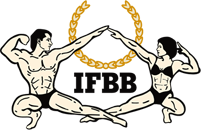
IFBB FITNESS CHALLENGE
RULES. January 2023.
IFBB FITNESS CHALLENGE 2023 consists of a circuit with strength exercises in 6 stations where athletes try to perform the maximum number of repetitions in 2 minutes.
Categories are established and athletes compete with each other demonstrating their maximum physical performance.
It is dedicated to athletes who prioritize muscle performance over competition based solely on muscle and lack of body fat.
KEY FACTORS
- healthy lifestyle
- outstanding physical performance
- opportunity for broad age levels
- personal satisfaction
- energy of a balanced body
Categories
Age and sex categories
Individual categories:
- Men’s Fitness Challenge (athletes between the age of 24 and 40)
- Women’s Fitness Challenge (athletes between the age of 24 and 35)
- Junior Men’s Fitness Challenge (athletes under 23 years old)
- Junior Women’s Fitness Challenge
- Master Men’s Fitness Challenge (athletes +40 years)
- Master Women’s Fitness Challenge (athletes + 35 years)
Categories of couples and teams.
- Couples Fitness Challenge (same-sex M/F couples and mixed couples)
- Team Fitness Challenge (team of 6 athletes of the same sex or mixed)
Categories by execution and performance levels:
- Gold Level
- Silver Level
- Bronze Level
- Speed Fitness Challenge (Gold and Silver)
OUTFIT AND SKIN
Unlike our Bodybuilding and Fitness categories, Fitness Challenge has no body display.
Sportswear covering the torso and legs may be used, as the musculature is not the target of the competition.
Athletes may wear tracksuits or T-shirts with shorts or any combination at their discretion.
Sports shoes are also mandatory.
Bronze cream for tanning and oils are not allowed.
METHODOLOGY and CRITERIA OF ARBITRATION AND SCORING
How is the FITNESS CHALLENGE competition developed?
INDIVIDUAL COMPETITION
- It is a 6 station circuit. In each station a different exercise is performed.
- In each station, the athlete performs a maximum of repetitions for a time of 2 minutes. In this time frame, the athlete can interrupt the exercise and resume it.
- Each athlete starts at station number 1 and at the end of the exercise, moves to the next one always following a numerical order. Progress until you complete the 6 exercises in the circuit.
- All athletes change stations at the same time, progressing to the next exercise in numerical order with a time of 2 minutes to rest and prepare for the next station.
- Up to 6 athletes compete simultaneously, each one in a station and with a judge / referee controlling technical correction and recording the repetitions performed.
- A judge / referee waits for the athlete at the next station. He controls the correct execution and records the repetitions performed on a control sheet that the athlete carries with him.
- Total time in each station is 2 minutes (run) + 2 minutes (station change) All athletes start the next exercise at the same time.
- All athletes go through all the exercises and must perform all of them correctly, adhering to the Regulations described for this purpose.
- The total time of the test, 24 minutes for 6 athletes (2 minutes to perform + 2 minutes to change stations and recover x 6 stations)
- Every time an athlete completes all 6 exercises, they finish and leave the circuit.
Athletes compete for maximum repetitions in each station.
These repetitions are noted on their control sheet.
In the case of a TIE between competitors who perform the same number of TOTAL REPETITIONS, the one who has made the highest number in BURPEE & DEVIL PRESS, KETTLEBELL SNATCHES or KETTLEBELL SWINGS (Gold, Silver or Bronze) will win.
In INDIVIDUAL COMPETITION, athletes classify by the sum of repetitions in the 6 exercises of the circuit.
ATHLETE’S ROLE
- The athlete will always follow the technical indications of the judge arbitrator.
- The athlete will perform as many repetitions of the exercise as possible at each station.
- The athlete will accept any repetitions that the judge/arbitrator deems valid.
- The athlete must respect the start of each exercise and interrupt it within 2 minutes. You can discontinue replays but you won’t do any beyond this time
- The athlete will move to the next station at the end of the 2 minutes. It will be positioned to start the next exercise when directed by the Center Judge or the Judge / Timekeeper.
- At the end of the 6 stations, the athlete hands over to the judge / central referee the control sheet with the repetitions performed in each station, for his signature and registration.
- At the end of the 6 stations, the athlete will leave the competition venue.
JUDGE/ARBITRATOR’S ROLE
- In each circuit there will be 6 judges/arbitrators, one assigned to each station.
- It is equipped with a board and forms and a pen to write down. Official clothing.
- The judge/arbitrator counts the valid repetitions each athlete performs at their station and writes them down on a control form. Counts out loud for the athlete to hear.
- Valid repetitions are those that are considered by the judge/arbitrator; those that it invalidates are null and void. They add up only valid repetitions.
- The judge/arbitrator controls the start and end of the exercise by following the orders of the central judge or judge/ timekeeper marking the time intervals.
- The judge/arbitrator waits for the next athlete to arrive at his/her station and accompanies during the 2-min break and position for the start of the exercise.
ROLE OF THE CENTRAL JUDGE
- The head judge manages the competition, managing the timer and instructing the judges / referee and collaborating with them on technical matters.
- He may delegate a judge / timekeeper to control the partial and total timings.
- The central judge collects the control sheet from each athlete at the end of the 6 exercises. He signs the control sheets for each athlete, couple or team and sends them to record.
The ROLES of ATHLETE, JUDGE / REFEREE AND CENTRAL JUDGE will be the same in the different modalities of INDIVIDUAL COMPETITION-COUPLES or TEAMS OF 6.
COMPETITION CATEGORIES BY COUPLES Couples Fitness Challenge
- They compete in pairs that perform the circuit in its 6 stations in the same order as the individual competition.
- Couples can be: only MEN, only WOMEN or MIXED.
- Both athletes execute the same exercise for each station of the circuit, alternating between them to achieve the highest number of repetitions in the 2 minutes.
- Both athletes pause the 2 minutes between stations together.
- Up to 6 couples work together, one per station, all of them starting with station 1 and progressing in order to the rest of the exercises.
- When the first couple finishes the 1st season, the next couple will join.
In the COMPETITION BY COUPLES, couples qualify by the sum of repetitions of both components in the 6 exercises of the circuit.
TEAM COMPETITION CATEGORY OF 6. Team Fitness Challenge
- Teams of 6 compete, occupying the entire circuit. Each team can include 4 + 2 athletes of each gender or 3 +3. Never just 1 athlete of one sex.
- Each component of the team occupies a station. They all work at the same time.
- Its 6 components are distributed in the stations at their convenience and all of them have to carry out the entire circuit in an orderly manner.
- The next team will start when the previous team has completed all the stations. There is only one team on the circuit while competing.
- The judge / referee of each station will count the valid repetitions of each team member on his personal control sheet (as in individual competition).
- The central judge will collect the sheets of all the athletes of the team and will add repetitions.
In the TEAM COMPETITION of 6, the teams are classified by the sum of repetitions of the 6 components in all exercises of the circuit.
In Individuals, Couples and Teams, competitions may be held on the GOLD and SILVER circuits, depending on the Organizer’s offer.
The offer of circuits by the Organizer will depend on the level of the Competition.
TECHNICAL REGULATION OF THE EXERCISES GOLD STANDARD
1 CHIN UPS (prone & strict)
START: full extension of the elbows; prono grip to shoulder width.
EXECUTION: climb until the chin exceeds the bar.
FINAL: return to the starting position. Elbows must be fully extended.
A stop of 1 second will be made in the starting position, full extended elbows. Rolling or swinging is not allowed at any time during the tour. Failure to do so marks repetition null.
2 Jump SQUAT (up to 20”-24″ box)
START: Two feet together on the ground, extended trunk, hips and knees..
EXECUTION: Jump two feet together on the box, trunk, hip and knees joints will be extended.
FINAL: return to the starting position. The athlete CANNOT bounce, he must stop and extend, without taking advantage of the fall from the previous jump.
Both feet are supported up and down simultaneously. Repetition is marked when returning to the ground. The box has a height of 20”-24” (women-men)
3 DIPS (feet forward)
START: up on the parallel bars, full extension of elbows.
EXECUTION: Going down to an elbow position at 90o
FINAL: Return to the starting position.
A stop of at least 1 second will be made in the up position, with elbows fully extended. Legs must be in front of the hand rest. Impulses are not allowed. Failure to do so marks repetition null.
4 Walking LUNGES (with a barbell)
START: feet together, barbell rests over the shoulders. Judges may help to raise the bar.
EXECUTION: We walk by lunges with 90o flexion in both knees.
FINAL: repetition is completed when knees, hips and trunk are in full extended position.
Bar must remain over the athlete’s shoulders for the whole 2 minutes. If not, exercise is over.
WEIGHT: bar with 30/50 kg for female/men.
The knee of the back leg touches the ground at each repetition to be counted valid.
5 SIT UPS (weighted)
START: lying down, knees and hips at 90o, plate on the chest with extended elbows.
EXECUTION: we incorporate by keeping the plate up.
FINAL: trunk perpendicular to the ground, arms completely extended over the head.
Lumbar and dorsal spine should be supported at each descent. Elbows extended all the time.
WEIGHT: 10 kilos plate for all participants.
The feet must maintain contact with the ground during the execution of the exercise.
6 Burpees & “Devil PRESS”
START: Standing, with the trunk extended, dumbbells on the sides.
EXECUTION: Burpee with bottom on the dumbbells up to 90º, the athlete can touch the ground with the chest. Return to standing upright position; curl and press with the dumbbells until arms extend overhead. Not accepting a snatch of the dumbbells.
FINAL: return to the starting position.
WEIGHT: dumbbells are pairs of 10/15 kg for female/male.
Failure to follow any indications marks repetition null.

TECHNICAL REGULATION OF THE EXERCISES SILVER LEVEL
1 PULL UPS (lying position)
START: PRONO grip at shoulder width. Suspended body with full elbow extension. Stop and count for at least 1 second at the start position.
EXECUTION: chest touches the bar. The body will always be straight. Rocking and pulsing are not allowed. The feet, ankles or calves rest on a bench or box.
FINAL: return to the starting position
2 Jefferson SQUAT
START: Feet supported, trunk, hips and knees extended. Bar between legs diagonally.
EXECUTION: Go down the barbell until the discs touch the ground
FINAL: Return to the starting position. The shoulders are set, spine, hips and knees fully extended. Not extending any joint makes repetition null.
WEIGHT: Bar with 40 kg for women and 60 kg for men.
3 DIPS on bench (feet forward)
START: hands on bench’s edge, full extended elbows. Legs ahead of the hand support. Feet on a bench or a box. Knees remain straight all the time.
EXECUTION: Move down to an elbow position by 90o. No impulses allowed.
FINAL: Return to the starting position. Stop for at least 1 second in the up position.
4 LUNGES (non walking, with dumbells)
START: feet together, dumbbells in your hands.
EXECUTION: lunges with steps of 90º in front and back knee. Return to upright with trunk, hip, and knee joints fully extended.
FINAL: one repetition is counted for each step taken.
WEIGHT: 10 kg dumbbells for women and 15 kg for men.
5SIT UPS (weight on chest)
START: lying down, knees and hips at 90o, disc on the chest.
EXECUTION: sit up keeping the disc parallel to the chest, it is not necessary to touch it; semi-flexed arms.
FINAL: trunk perpendicular to the ground. When descending to the lying position, the lumbar and dorsal spine should be supported.
WEIGHT: 10 kg plate for all participants.
6 SNATCHES (with kettlebell)
START: standing, trunk extended, kettlebell in one hand.
EXECUTION: bend down until you touch the ground with the kettlebell and lift it until you have your arm extended over your head. It is not valid to raise KB to the front; always on top.
FINAL: return to the starting position. The KB touches the ground. You can switch hands.
WEIGHT: 8 kg kettlebell for women and 12 kg for men.






